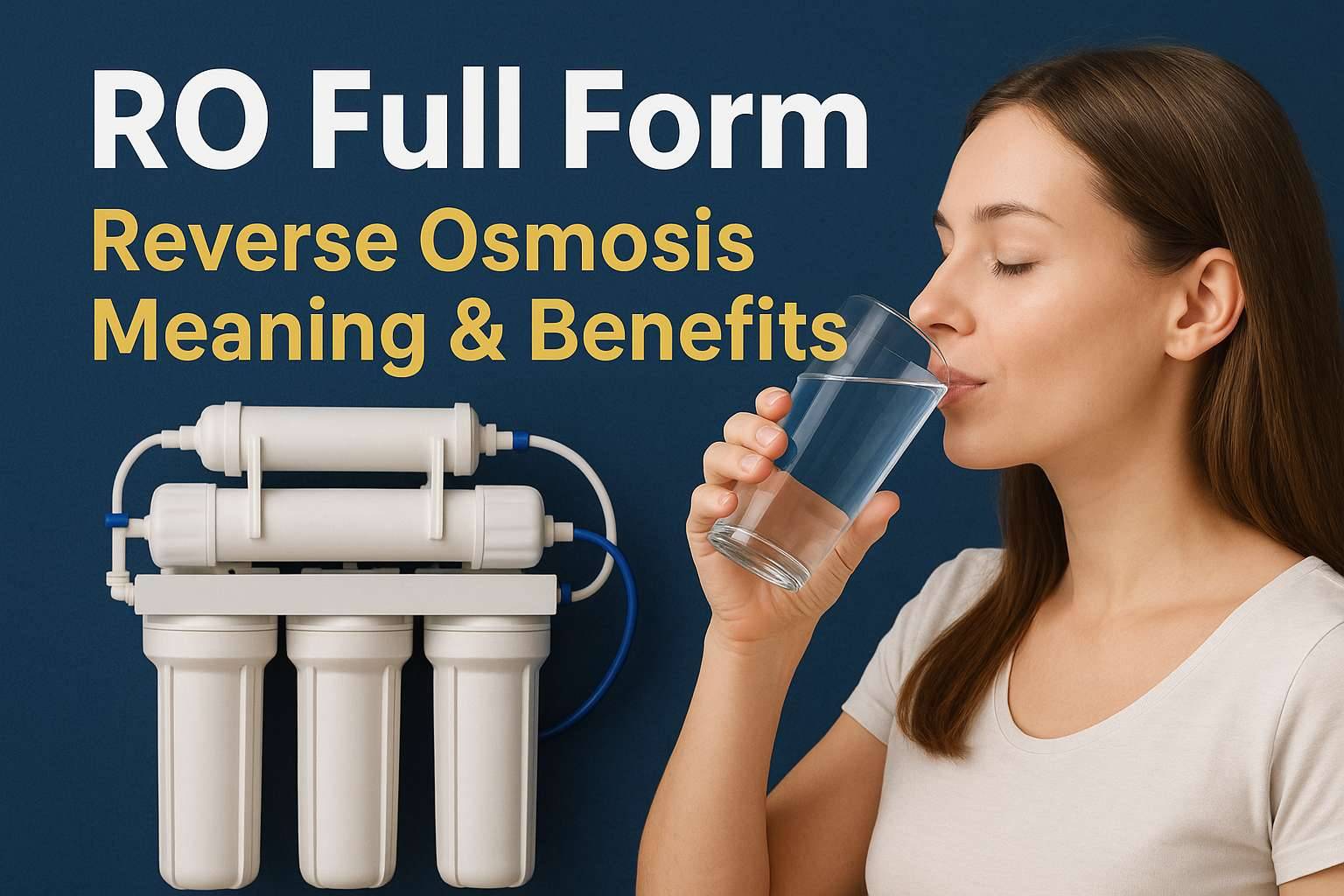Water is the foundation of life, yet according to WHO, nearly 2 billion people globally drink contaminated water that poses serious health risks. As urban populations grow and industrial pollution worsens, access to safe drinking water is becoming increasingly difficult. This is where RO (Reverse Osmosis) technology plays a crucial role — offering a reliable way to purify water and protect health. But what exactly does RO mean, and how does it work?
RO Full Form: Reverse Osmosis
The RO full form is Reverse Osmosis, a scientific process that purifies water by removing dissolved salts, chemicals, and harmful microorganisms through a semi-permeable membrane. It is one of the most effective purification technologies in the world and is widely used for domestic, commercial, and industrial purposes.
Snippet:
RO Full Form – Reverse Osmosis: A water purification process that removes dissolved salts, heavy metals, and contaminants using a semi-permeable membrane, delivering clean, safe drinking water.
What is Reverse Osmosis?
Reverse Osmosis is a process where water is pushed through an extremely fine membrane under high pressure. This membrane allows only pure water molecules to pass through while blocking harmful contaminants like lead, mercury, arsenic, bacteria, and fluoride. The result is crystal-clear, safe drinking water that is free from impurities, unpleasant odor, and bad taste.
In simple terms, Reverse Osmosis does the opposite of natural osmosis. Instead of water moving from a region of low concentration to high concentration, it reverses the flow — hence the name Reverse Osmosis.
How Does an RO Water Purifier Work?
Every RO system follows a multi-stage purification process. Each stage targets specific impurities, ensuring that the water you drink is completely safe and healthy.
Pre-Filtration Stage
In this first step, sediment and carbon filters remove visible impurities like dust, mud, and chlorine. It helps protect the RO membrane from clogging and damage.
RO Membrane Purification
At this stage, water is forced through a semi-permeable membrane under pressure. The membrane traps microscopic particles, bacteria, and dissolved salts that are invisible to the naked eye.
Post-Carbon Filtration
Here, the purified water passes through an activated carbon filter that enhances taste and removes any remaining odor or chemical residue.
Storage and Dispensing
The final purified water is stored in a tank, ready for use. Most modern systems include an auto-cutoff function that prevents overflow and ensures hygiene.
Key Stages of the RO Purification Process
Each stage in the RO system contributes to a complete purification process that enhances both water quality and safety.
-
Sediment Filtration: Eliminates sand, dust, and rust particles that can damage the RO membrane.
-
Pre-Carbon Filtration: Absorbs chlorine and organic impurities that affect taste and odor.
-
RO Membrane Stage: Removes up to 99% of dissolved solids, bacteria, and harmful metals.
-
UV or UF Stage: Destroys any leftover microorganisms and ensures biological safety.
-
Post-Carbon Filtration: Polishes water by enhancing clarity, flavor, and freshness.
-
TDS Control Stage: Adjusts mineral levels for balanced taste and nutritional value.
Together, these stages guarantee that every glass of water is free from contamination and suitable for long-term health.
Importance of RO Water in Daily Life
Clean water is essential for digestion, metabolism, and overall well-being. Unfortunately, water sources in many cities are contaminated with harmful chemicals and microbes. RO purification plays a crucial role in protecting families from waterborne diseases such as typhoid, dysentery, and hepatitis.
RO purified water not only prevents illness but also improves daily comfort. It enhances the taste of beverages like tea and coffee, keeps appliances like kettles and irons free from scaling, and ensures food tastes natural and fresh when cooked.
Benefits of RO Water Purifiers
Using an RO system ensures that every drop of water you drink is free from invisible threats. Below are the major benefits explained in detail.
-
Eliminates Harmful Contaminants: Removes dissolved salts, heavy metals, and pesticides that pose long-term health risks.
-
Improves Water Taste and Smell: Gets rid of chlorine, sulfur, and metallic odors for a cleaner, fresher taste.
-
Reduces TDS Levels: Balances Total Dissolved Solids, making hard or salty water suitable for consumption.
-
Ensures Health Safety: Protects against bacteria, viruses, and parasites that cause severe infections.
-
Ideal for All Water Sources: Works effectively for borewell, tanker, or municipal water.
-
Improves Cooking and Beverage Quality: Helps retain the natural flavor and color of food and drinks.
-
Convenient and Continuous Supply: Provides purified water instantly without boiling or chemical treatment.
-
Supports Long-Term Wellness: Promotes better hydration, digestion, and kidney function.
These combined benefits make RO water purifiers a household essential, especially in regions where water quality is unreliable.
Drawbacks of RO Systems and Practical Solutions
Even though RO technology is highly effective, it has some drawbacks. Fortunately, these can be easily managed with advanced features and proper care.
-
Removes Good Minerals Too: Some essential minerals like calcium and magnesium are filtered out. Choose models with a mineralizer or TDS controller to retain them.
-
Water Wastage Issue: Older RO systems waste up to 3 liters for every liter purified. Modern water-saving RO units reduce this significantly by recycling reject water.
-
Needs Regular Maintenance: Filters and membranes require periodic cleaning and replacement. Annual servicing keeps the unit efficient.
-
Electricity Dependence: RO purifiers need power to operate; consider a backup if power cuts are frequent.
-
Higher Initial Investment: Though costlier upfront, the long-term health benefits outweigh the expense.
When maintained correctly, an RO system provides safe and consistent water quality for many years.
RO vs UV vs UF – Detailed Comparison
Different purification methods serve different water conditions. Here’s a comparison of the three most common systems:
| Feature | RO (Reverse Osmosis) | UV (Ultraviolet) | UF (Ultrafiltration) |
|---|---|---|---|
| Removes TDS | Yes | No | No |
| Kills Bacteria & Viruses | Yes | Yes | Yes |
| Removes Heavy Metals | Yes | No | No |
| Retains Essential Minerals | No | Yes | Yes |
| Electricity Requirement | Yes | Yes | No |
| Ideal Water Source | Borewell / Hard Water | Municipal Supply | Low-TDS Water |
If your water source has high TDS or a salty taste, RO purification is the most effective choice. For city areas with soft water, UV or UF systems can also work efficiently.
When Should You Install an RO Purifier?
It’s essential to analyze your water quality before choosing a purifier. You should install an RO system if:
-
The TDS level exceeds 500 ppm, indicating hard or saline water.
-
You depend on borewell, tanker, or untreated groundwater sources.
-
You experience foul odor or metallic taste in your drinking water.
-
Your family includes children, elderly, or people with sensitive health conditions.
-
The area has frequent water contamination due to pipelines or storage tanks.
Regular testing of your water source helps determine if an RO purifier is necessary or if a UV/UF model would suffice.
How to Maintain an RO Water Purifier
Maintenance is the key to long-lasting performance and consistent purity. A well-maintained system ensures that every component functions effectively.
-
Replace Filters on Schedule: Sediment and carbon filters should be changed every 6–12 months.
-
Clean the RO Membrane: Check and replace it every 2–3 years depending on usage and TDS level.
-
Sanitize the Tank: Clean the storage tank quarterly to prevent microbial buildup.
-
Inspect Tubing and Fittings: Ensure there are no leaks or loose joints in the system.
-
Check TDS Regularly: Keep water within the safe range of 50–150 ppm for balanced taste.
-
Annual Professional Service: Helps detect hidden issues and extends purifier lifespan.
Proper maintenance not only improves efficiency but also reduces long-term repair costs.
Common RO Problems and Easy Fixes
Even the best systems face occasional problems. Knowing how to troubleshoot them can save time and ensure uninterrupted water supply.
-
Low Water Flow: Usually due to clogged filters or a weak pump; cleaning solves it.
-
Unpleasant Taste: Indicates filter or carbon cartridge needs replacement.
-
Water Leakage: Commonly caused by loose pipe fittings or worn-out O-rings.
-
Noise During Operation: Air trapped in the filter system can cause vibration; flushing helps.
-
No Water Output: Might occur due to power supply issues or damaged membrane.
Always consult a professional technician if the problem persists beyond basic maintenance.
Future of RO Technology
RO purification is evolving rapidly with innovations focused on efficiency and sustainability. The next generation of systems is smarter, faster, and environmentally conscious.
-
Water Recovery Systems: Recycle waste water, saving up to 80% compared to older models.
-
Smart Connectivity: IoT-enabled purifiers send maintenance alerts via mobile apps.
-
Mineral Booster Technology: Restores healthy minerals for balanced water.
-
Compact, Sleek Designs: Modern units complement modern kitchen aesthetics.
-
Energy Efficiency Improvements: Reduce electricity consumption during purification.
-
Zero Water Wastage Models: Offer closed-loop filtration for eco-friendly homes.
These advancements ensure that RO systems remain the most reliable purification choice for future generations.
FAQs on RO Full Form and Water Purifiers
Q1. What is the full form of RO?
RO stands for Reverse Osmosis, a process that purifies water by removing dissolved solids, bacteria, and harmful contaminants.
Q2. Is RO water safe for everyday use?
Yes, RO water is completely safe for daily consumption. It is free from impurities, chemicals, and pathogens.
Q3. Does RO water remove essential minerals?
Yes, but modern purifiers include TDS controllers or mineral cartridges that restore these minerals safely.
Q4. How often should I change RO filters?
Typically every 6–12 months for pre-filters and 2–3 years for membranes, depending on water quality.
Q5. Can RO work with salty or borewell water?
Absolutely. RO technology is best suited for hard or high-TDS water sources, including borewells and tankers.
Q6. Why is RO water better than boiling?
Boiling kills bacteria but doesn’t remove dissolved salts or metals. RO does both, offering comprehensive purification.
Q7. What TDS level is ideal for drinking water?
The ideal TDS range for drinking water is 50–150 ppm, offering a perfect balance of purity and taste.
Final Thoughts
The RO full form – Reverse Osmosis – represents far more than just a filtration system. It’s an advanced, scientifically designed purification process that guarantees pure, safe, and great-tasting water for every household. With rising pollution levels and decreasing freshwater quality, an RO water purifier is no longer optional — it’s essential.
Modern RO systems now come equipped with smart features, mineral balancing, and eco-friendly designs that make them both efficient and sustainable. When maintained properly, they can provide long-term protection for your family’s health, ensuring every drop of water is clean, safe, and pure.





